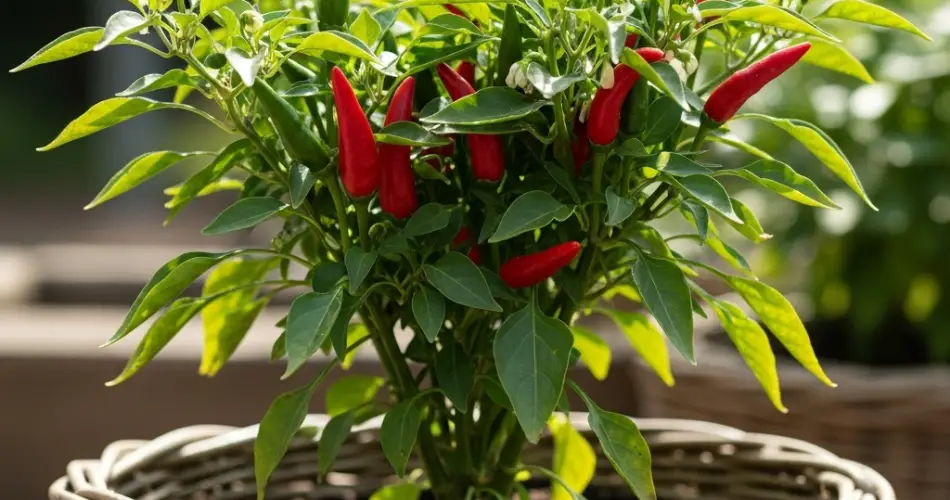Chili peppers are a flavorful, versatile, and heat-packed addition to any home garden. For urban gardeners and those with limited outdoor space, basket planting provides a convenient and productive way to grow chili peppers. With proper care and strategic planting, basket-grown chilies can provide a continuous harvest throughout the season, delivering fresh, homegrown spice right to your kitchen.
Why Baskets Work for Chili Peppers
Baskets are ideal containers for chili peppers because they provide excellent drainage, airflow, and root space. Unlike in-ground planting, baskets reduce the risk of soil-borne diseases and make it easier to control watering and nutrient levels. The elevated position of basket containers also minimizes pest problems and improves air circulation around the plants. For small-space gardeners, baskets maximize vertical and horizontal space, making chili pepper cultivation feasible even on balconies or terraces.
Choosing the Right Basket
Selecting an appropriate basket is critical for successful chili pepper growth. Choose a container at least 10–12 inches deep to accommodate the root system, with a width sufficient for one or two plants depending on the variety. Ensure the basket has multiple drainage holes to prevent waterlogging, which can damage roots and reduce yield. Woven baskets, fabric pots, or other breathable containers are ideal, as they allow airflow, maintain proper moisture levels, and are lightweight enough for easy relocation.
Preparing the Soil
Chili peppers thrive in nutrient-rich, well-draining soil. Use a high-quality potting mix blended with compost or aged organic matter to provide essential nutrients for strong root and foliage development. Avoid heavy garden soil that can compact in containers and restrict root growth. Chili peppers prefer slightly acidic to neutral soil, with a pH between 6.0 and 7.0. Incorporating a slow-release organic fertilizer at planting helps support early growth, while supplemental feeding with liquid fertilizer every two to three weeks encourages continuous flowering and fruiting.
Selecting Chili Pepper Varieties for Baskets
Not all chili varieties are ideal for basket cultivation. Compact, bush-type peppers or dwarf varieties are particularly suited for containers, as they remain manageable while producing abundant fruit. Popular choices include small hot peppers, such as cayenne, bird’s eye, and jalapeño, which offer continuous yields without overcrowding the basket. Selecting varieties adapted to container growth ensures better results and easier care.
Planting Chili Peppers in Baskets
Planting chili peppers in baskets requires careful attention to spacing and depth:
-
Fill the basket with prepared soil, leaving 1–2 inches from the top.
-
Plant seedlings at appropriate spacing, usually one or two plants per basket for compact varieties.
-
Firm the soil gently around the roots and water thoroughly.
-
Provide support with small stakes or cages for taller or vining varieties.
Proper planting encourages healthy root development, strong stems, and optimal fruit production.
Caring for Basket-Grown Chili Peppers
Consistent care is essential for basket-grown chilies. Keep the soil evenly moist but avoid overwatering, as waterlogged conditions can lead to root rot. Baskets dry out faster than in-ground beds, so monitor moisture levels regularly, particularly during hot weather. Chili peppers thrive in full sun, requiring at least 6–8 hours of direct sunlight daily.
Pruning small shoots or yellowed leaves improves airflow, reduces disease risk, and focuses the plant’s energy on producing fruit. Mulching with straw or organic material helps conserve moisture and maintain a stable soil temperature.
Fertilizing for Continuous Harvest
Regular feeding encourages steady flowering and fruiting. Apply a balanced liquid fertilizer every two to three weeks to provide essential nutrients for growth and pepper development. Avoid excessive nitrogen, which promotes lush foliage at the expense of fruiting. A well-nourished plant will produce peppers consistently throughout the season.
Harvesting Chili Peppers
Chili peppers can be harvested at various stages, depending on flavor and heat preference. Regular harvesting encourages continued production, as it prevents the plant from becoming stressed or overburdened with mature fruit. Gently twist or cut the peppers from the stem to avoid damaging branches. Small, hot varieties are particularly suited for successive harvests, providing a constant supply of fresh chilies for cooking, pickling, or drying.
Pest and Disease Management
Baskets reduce many common soil-borne issues, but chili plants can still face pests such as aphids, spider mites, or whiteflies. Inspect plants regularly and remove affected leaves. Organic treatments like neem oil or insecticidal soap are effective and safe for home use. Maintaining proper spacing, pruning, and watering helps prevent disease and keeps plants healthy throughout the growing season.
Benefits of Basket-Grown Chili Peppers
Growing chili peppers in baskets offers multiple benefits. It maximizes small-space gardening potential, allows control over soil and nutrients, and reduces the risk of pest and disease problems. Container-grown peppers are often more flavorful than store-bought varieties, while providing the convenience of having fresh, spicy produce at your fingertips. Baskets also add greenery and charm to balconies, patios, and terraces, making urban gardening both productive and visually appealing.
Conclusion
Basket planting makes growing chili peppers simple, manageable, and rewarding, even in limited spaces. By choosing the right container, soil, and variety, and providing consistent care and regular harvesting, gardeners can enjoy a continuous supply of fresh, spicy chilies throughout the season. This method transforms small spaces into vibrant, productive gardens, offering both culinary delight and the satisfaction of homegrown produce.



